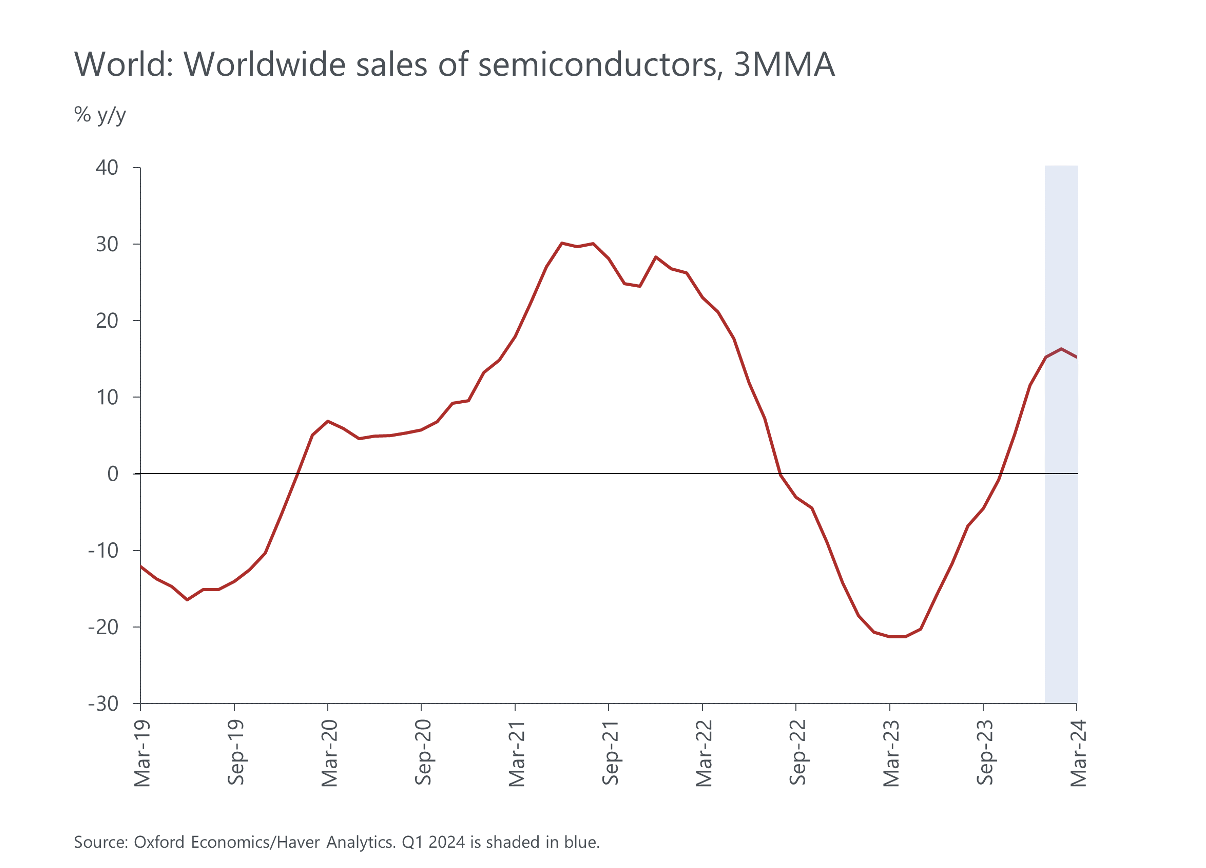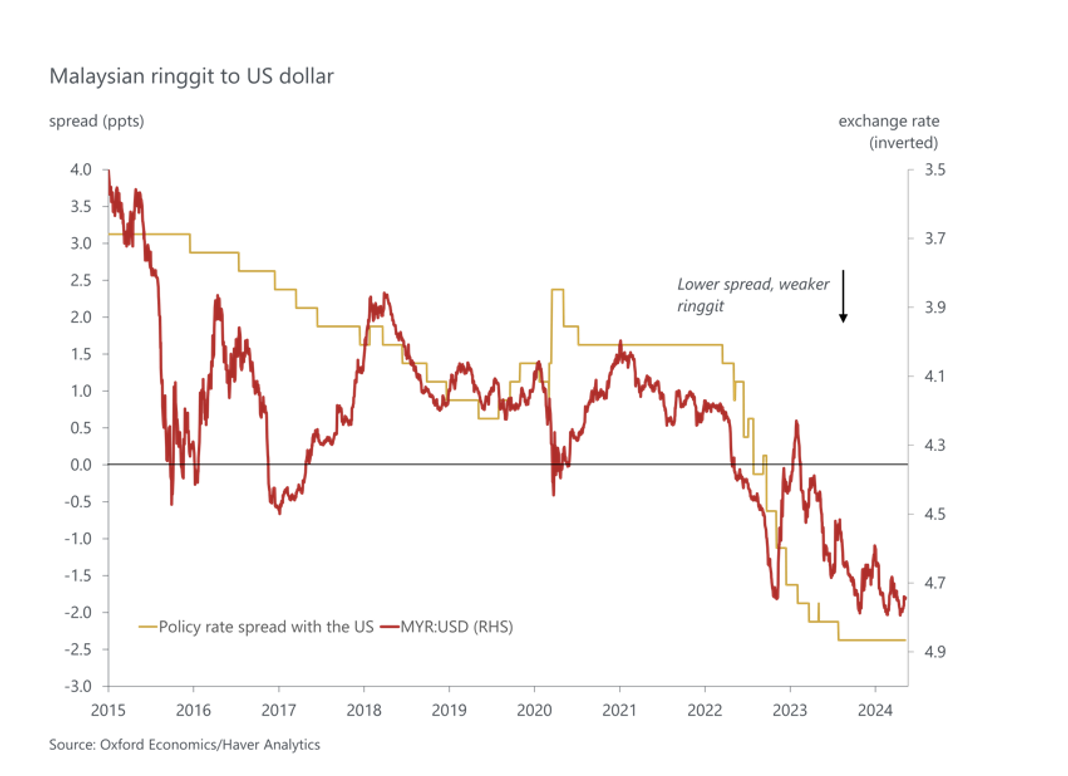ICAEW: Q1 2024 economic growth in Southeast Asia and Malaysia buoyed by electronics exports, but cautious outlook remains
By Digital News Asia June 18, 2024
- The electronics cycle's bottoming out is expected to boost Malaysian exports.
- Malaysia expected to benefit from the electronics recovery in the 2nd half of 2024

Oxford Economics, in research commissioned by the Institute of Chartered Accountants in England and Wales (ICAEW), reported that the electronics sector is a bright spot for Southeast Asia’s economy, with the region projected to grow by 4.0% in 2024 and 2025. However, this is below the pre-pandemic average of 5% in the five years prior, largely due to expected challenges in domestic consumption as interest rates remain higher for longer.

The report highlights that electronics-focused exporters in Southeast Asia gained a better foothold in Q1 2024, in large part due to the bottoming out of the electronics sector. It said the recovery in global semiconductor sales, which saw a 15.3% year-on-year increase in Q1 2024, has particularly benefited Vietnam, where export growth soared to an estimated 16.8% year-on-year. On a seasonally adjusted basis, Singapore also saw a rebound in non-oil domestic exports in April with an estimated 9.4% month-on-month growth, marking a positive turn after two consecutive months of decline.
It added that Malaysia is expected to benefit from the electronics recovery in the second half of the year, given its position further down the electronics value chain. Nevertheless, the boost from the electronics sector in Southeast Asia remains softer compared to other Asian semiconductor heavyweights like Taiwan and South Korea.

Global tight monetary policies are likely to weigh down external demand for the region's exports, making recovery modest, the report stated, adding that the global growth forecast of 2.6% for 2024, lower than pre-pandemic levels, will also dampen regional export growth.
On the bright side, Southeast Asia's tourism industry has seen steady visitor growth since November 2023, partly due to various visa-free travel programs with China. This has led to the increase of intraregional travel within Southeast Asia. However, supply-side constraints, such as limited flight capacity and a shortage of hotel rooms, could hinder the region’s ability to fully meet resurgent tourist demand. As a result, the recent rapid growth in tourist arrivals is likely to decelerate.
Domestic consumption faces near-term challenges
According to the report, domestic consumption in Southeast Asia was more resilient than expected in Q1 2024. However, it is unlikely to drive growth in the coming quarter as tight monetary policy in the region is expected to restrain consumer spending.
The persistent weakness in local currencies against the US dollar is likely to limit monetary easing options for Southeast Asian central banks. The strong US dollar, driven by the Federal Reserve's high interest rates, prevents local central banks from cutting rates without risking further currency depreciation. In Q1 2024, Bank Indonesia was even forced to raise rates to arrest the rupiah’s decline.
The ongoing tight monetary policy means that debt servicing and borrowing costs will remain high, likely constraining private consumption. Additionally, many consumers and businesses are continuing to consolidate as they are still recovering from the pandemic and are likely to focus on rebuilding savings or repairing their balance sheets in the short term, the research indicated.
At the same time, governments are also consolidating to offset pandemic-related fiscal payouts by raising taxes and reducing spending. Singapore and Thailand both raised taxes this year, and Indonesia is preparing to do so in 2025. Malaysia is planning to adjust RON95 subsidies that were scheduled in the second half of the year, moving from a blanket policy to a more targeted approach.
There is a glimmer of hope as the US Federal Reserve is expected to cut rates in Q3 2024. This could alleviate pressure on regional currencies, potentially allowing Southeast Asian central banks to ease their monetary policies.
Malaysia: Q1 2024 economic growth buoyed by electronics exports but cautious outlook remains
In Q1 2024, Malaysia experienced a notable economic upturn, with GDP expanding from a revised 2.9% year-on-year in Q4 2023 to a robust 4.2%, coupled with a remarkable 1.4% quarter-on-quarter growth in seasonally adjusted terms, effectively reversing the 1.0% contraction observed in the previous quarter. This positive momentum, however, faces challenges in sustainability.
A significant driver of growth was the remarkable surge of 9.7% quarter-on-quarter in exports, predominantly fueled by the resurgence of Chinese tourists during the Chinese New Year holiday in February. This resurgence can be attributed, in part, to the bilateral visa-free arrangement initiated in December 2023. Nonetheless, there are doubts regarding the longevity of this surge, as initial boosts tend to fade over time.
Retail sales volumes also demonstrated a notable recovery, with a 4.4% month-on-month increase in February following four consecutive months of decline. However, this resurgence appeared to lose steam in March, with retail sales growing only by 0.7%. Despite a healthy labor market and historically low unemployment rates, there are emerging signs of softness, evident in stuttering new job growth and cooling wage growth, indicating a potential future moderation in consumer spending.
In terms of domestic demand, the research showed that government consumption is anticipated to remain flat or even decline, as evidenced by recent budget plans aimed at nominal reductions in spending. Additionally, fuel subsidies are being curtailed to mitigate the budget deficit and improve the public debt-to-GDP ratio. Investment, particularly within the industrial sector, is likely to face constraints amid the prevailing uncertain external environment.
Regarding the external sector, exports are projected to experience modest growth in 2024, albeit tempered by subdued global demand. The anticipated bottoming out of the electronics cycle is expected to positively impact Malaysian exports, although this effect may not be fully realized until the second half of the year due to the country's position within global supply chains.
The Malaysian ringgit encountered significant challenges in Q1 2024, largely attributed to the substantial discount of the Bank Negara Malaysia’s (BNM) policy rate relative to the US Federal Funds rate. Despite inflation remaining relatively low, hovering below 2% for the past six months and showing little indication of significant increase, the currency weakness poses an obstacle to BNM's ability to ease policy to support the economy. This challenge persists until the US Federal Reserve initiates rate cuts, anticipated to occur in Q3, alleviating pressure on the ringgit and potentially enabling policy rate adjustments.
While Malaysia's Q1 2024 GDP growth showcased resilience, primarily supported by robust electronics exports, the economic outlook remains cautious due to challenges in both domestic consumption and external demand. However, the Malaysian economy is expected to exhibit modest growth throughout 2024, and although uncertainties persist regarding global economic conditions and domestic policy responses, Bank Negara Malaysia remains confident that there are upside risks from greater spillover from the tech upcycle, more robust tourism activities and faster implementation of existing and new investment projects.

In summary
- Malaysia's GDP grew by 4.2% year-on-year in Q1 2024, supported by electronics exports.
- The outlook for sustained growth remains cautious due to challenges in domestic consumption and global economic conditions.
- Government policies and supply-side constraints continue to influence economic dynamics in Malaysia.
Other findings from the Economic Update Q2 2024 include:
Singapore: Trade-weighted economy will remain subdued
- Singapore’s GDP grew 2.7% year-on-year in Q1 while seasonally adjusted Q1 GDP grew slightly by 0.1% quarter-on-quarter.
- Singapore's economic momentum is likely to be subdued, despite strong electronics exports.
- Overall growth will likely remain slightly below trend this year, weighed down by soft domestic demand.
Indonesia: Shift in monetary policy likely to be delayed
- Indonesia's economy grew by 5.1% year-on-year in Q1 2024, up from 5.0% in Q4 2023.
- Domestic consumption, both in the private and public sectors, continues to drive resilience, with the latter likely bolstered by election-related spending.
- The external sector will be a drag, given soft global growth. Trade figures are showing sideways movement while lower external demand will also weigh on business investment.
- Bank Indonesia is expected to maintain rates until Q4 2024, with a potential 25 basis points rate cut following the US Federal Reserve’s rate cut.
Vietnam: A soft 2024, but a bright medium-term outlook
- Vietnam’s real GDP grew by 5.6% year-on-year in Q1 2024, down from 6.7% in Q4 2023.
- Exports remained robust in early 2024, driven by electronics and agriculture.
- Poor sentiment, capital deployment, and consumption are expected to remain drags, with credit growth at its joint-slowest in 10 years as of March. Year-to-date credit growth, or the amount of loans from commercial banks, was only at 1.3% year-on-year in March after two months of negative figures.
- Economic momentum is likely to improve gradually in H2 2024 as Vietnam benefits from the reshuffling of the structural supply chain from China, attracting foreign direct investment.
Related Stories :


